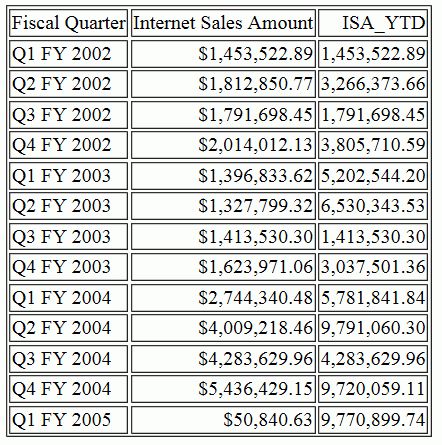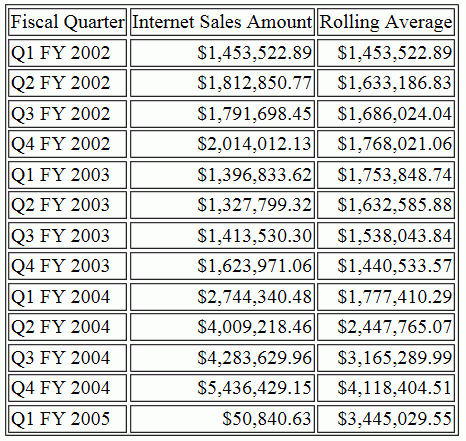OLAP Adapters
|
Topics: |
This section provides detailed descriptions of new features for OLAP adapters.
Adapter for Essbase
The Adapter for Essbase now supports Essbase 11.1.2.3 and 11.1.2.4 on the Windows 64-bit platform.
Adapter for Microsoft SQL Server Analysis Services (SSAS)
|
Topics: |
You can use the DB_EXPR function to calculate temporary measures and use currency and percent display options for measures.
Creating Temporary Calculated Measures Using DB_EXPR
You can use the DB_EXPR function to generate a query-scope calculated measure as an MDX expression. The result of that expression must be type value. In the calculated measure expression, you can use any MDX function.
You are responsible for how the expression will work in the context of the whole generated MDX query. For example, note that if the expression references the [Calendar] hierarchy, the result will depend on which (if any) level of that hierarchy is referenced in a BY clause of the TABLE request. If the level is not taken into account, the query may produce unexpected results or errors.
Example: Using MDX Functions in a Calculated Measure
The following request references three MDX functions to define the ISA_YTD measure, one member type function (CURRENTMEMBER), and two value type functions (Sum, Ytd).
DEFINE FILE ADVENTURE_WORKS_MIXED_CASE ISA_YTD/D20.2 WITH Internet_Sales_Amount = DB_EXPR(Sum(Ytd( [Date].[Calendar].CURRENTMEMBER ), [Measures].[Internet Sales Amount])); END TABLE FILE ADVENTURE_WORKS_MIXED_CASE SUM Internet_Sales_Amount ISA_YTD BY Fiscal_Year NOPRINT BY Fiscal_Quarter ON TABLE SET PAGE NOPAGE END
The following MDX request is generated, which includes the calls to the MDX functions.
WITH
MEMBER [Measures].[ISA_YTD] as '
Sum(Ytd( [Date].[Calendar].CURRENTMEMBER ),
[Measures].[Internet Sales Amount])'
SET H24 as '
[Date].[Calendar].[Calendar Quarter].ALLMEMBERS'
SET H33 as '
[Date].[Fiscal].[Fiscal Year].ALLMEMBERS'
SELECT {
[Measures].[Internet Sales Amount],
[Measures].[ISA_YTD]}
ON AXIS(0),
NON EMPTY CROSSJOIN(H24,
H33)
DIMENSION PROPERTIES
MEMBER_CAPTION
,[Date].[Calendar].[Calendar Quarter].[Fiscal Quarter] ON AXIS(1)
FROM [Adventure Works] The output is shown in the following image.

The following request references three MDX functions to define the measure I_S_A_4_MONTHS_ROLLING_AVERAGE, two member type functions (CURRENTMEMBER and Lag), a range (:), and one value type function (Avg).
DEFINE FILE ADVENTURE_WORKS_MIXED_CASE
I_S_A_4_MONTHS_ROLLING_AVERAGE/D20.2M
WITH Internet_Sales_Amount =
DB_EXPR(Avg({ [Date].[Calendar].CURRENTMEMBER.Lag(3)
: [Date].[Calendar].CURRENTMEMBER },
[Measures].[Internet Sales Amount]));
END
TABLE FILE ADVENTURE_WORKS_MIXED_CASE
SUM Internet_Sales_Amount
I_S_A_4_MONTHS_ROLLING_AVERAGE AS 'Rolling Average'
BY Fiscal_Year NOPRINT
BY Fiscal_Quarter
ON TABLE SET PAGE NOPAGE
END The following MDX request is generated, which includes the calls to the MDX functions.
WITH
MEMBER [Measures].[I_S_A_4_MONTHS_ROLLING_AVERAGE] as '
Avg({ [Date].[Calendar].CURRENTMEMBER.Lag(3)
: [Date].[Calendar].CURRENTMEMBER },
[Measures].[Internet Sales Amount])'
SET H24 as '
[Date].[Calendar].[Calendar Quarter].ALLMEMBERS'
SET H33 as '
[Date].[Fiscal].[Fiscal Year].ALLMEMBERS'
SELECT {
[Measures].[Internet Sales Amount],
[Measures].[I_S_A_4_MONTHS_ROLLING_AVERAGE]}
ON AXIS(0),
NON EMPTY CROSSJOIN(H24,
H33)
DIMENSION PROPERTIES
MEMBER_CAPTION
,[Date].[Calendar].[Calendar Quarter].[Fiscal Quarter] ON AXIS(1)
FROM [Adventure Works] The output is shown in the following image.

Support for Display Options M, p, and %
The following display options are now supported and are used when generating synonyms for the sample data sources provided with SQL Server Analysis Services.
- M, which places a floating currency symbol to the left of a measure.
- p, which converts a measure to a percent by multiplying it by 100, and then displays it with a percent symbol on the right.
- %, which does no conversion, but displays the existing measure with a percent symbol on the right.
Example: Using the Display Options M, p, and %
The following request prints INTERNET_SALES_AMOUNT twice, first with no currency symbol, and then with a currency symbol (M option). It prints GROSS_PROFIT_MARGIN three times, first as a number, then as a percent (p option), and last as a number with a percent symbol (% option).
TABLE FILE ADVENTURE_WORKS_UPPER_CASE PRINT INTERNET_SALES_AMOUNT/P20.2 AS 'P20.2' INTERNET_SALES_AMOUNT/P20.2M AS 'P20.2M' GROSS_PROFIT_MARGIN/F10.4 AS 'F10.4' GROSS_PROFIT_MARGIN/F10.2p AS 'F10.2p' GROSS_PROFIT_MARGIN/F10.4% AS 'F10.4%' BY COUNTRY ON TABLE SET PAGE NOPAGE ON TABLE SET STYLE * GRID=OFF,$ ENDSTYLE END
The output is shown in the following image.

Data Analysis Expression (DAX) Passthrough
A sample DAX query can be executed using the existing MDX Passthru mechanism. The recommended way is to place a DAX query into a file with extension .sql and create a synonym for it. The synonym can be further edited for attributes such as proper formatting. Reporting is then done against that synonym.
Adapter for TM1
|
Topics: |
The Adapter for TM1 is a special configuration of the Adapter for SQL Server Analysis Services. Configure the Adapter for TM1 by selecting TM1OLAP Provider on the Change Settings for SQL Server Analysis Services page of the Web Console. You must also provide the default database and, possibly, additional connection string parameters on the Change Connect Parameters for SQL Server Analysis Services Web Console page. The Adapter for TM1 supports Cognos Access Manager (CAM) authentication and Integrated Login.
CAM Authentication Support
To configure Cognos Access Manager (CAM) authentication, you must add the CAMNamespace parameter to the connection string.
You can configure this parameter on the Web Console. To configure the Adapter for TM1, use the Add Connection page for the Adapter for SQL Server Analysis Services, as shown in the following image.

For TM1, the catalog to be accessed must be part of the connection string. Enter the catalog name in the Default Database text box in order to add it to the connection string.
Enter the CAMNamespace parameter in the Additional connection string keywords text box. It will be added to the connection string as the ProviderString parameter when you press Configure. For example, if you enter CAMNamespace=NTLM_NAMESPACE, a connection string similar to the following is generated in the edasprof.prf server profile:
ENGINE SSAS SET CONNECTION_ATTRIBUTES CON1 SQL2012x64-02/user1,pwd1;SData:CAMNamespace=NTLM_NAMESPACE
The ENGINE SSAS SET PROVIDER TM1OLAP command must be in effect when using the Adapter for TM1. This command can be issued in edasprof.prf or in a FOCEXEC.
Integrated Login Support
Integrated Login enables you to use Microsoft Windows network authentication to control access to IBM Cognos TM1 data.
In this security model, user and group Microsoft Windows login information has to be moved into the Cognos TM1 database. Integrated Login matches the domain-qualified name you use to sign in to Microsoft Windows with a name stored in the internal database.
Integrated Login is supported on Microsoft Windows only.
You can configure Integrated Login in the Web Console, using the Add Connection page of the Adapter for SQL Server Analysis Services. When you configure the Adapter for TM1, select a trusted connection, as shown in the following image.

The connection string must specify the name of the TM1 catalog to be accessed. Enter the catalog name in the Default Database text box. A connection string similar to the following will be generated in the edasprof.prf server profile.
ENGINE SSAS SET CONNECTION_ATTRIBUTES CON1 SQL2012x64-02/,;SData
Since the connection is configured as trusted, no user ID or password is included in the connection string. The Integrated SSPI login causes the credentials from the Windows login to be used to access TM1.
The ENGINE SSAS SET PROVIDER TM1OLAP command must be in effect when using the Adapter for TM1. This command can be issued in the Server Profile or in a FOCUS procedure.
| WebFOCUS | |
|
Feedback |